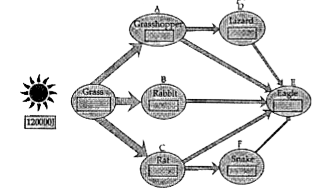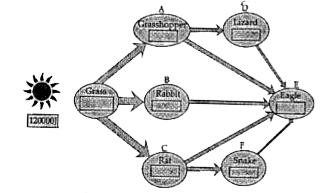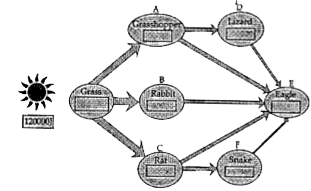A constant flow of solar energy to various trophic levels is supplied by the
Carnivores
Omnivores
Herbivores
Producers
Step-by-Step Solution:
1. Understanding the Question: The question asks about the source that supplies a constant flow of solar energy to various trophic levels in an ecosystem.
2. Identifying Trophic Levels: In an ecosystem, there are different levels of organisms known as trophic levels. These include producers (plants), primary consumers (herbivores), secondary consumers (carnivores), and so on.
3. Role of Producers: Producers, primarily plants, are at the base of the trophic levels. They are capable of capturing solar energy through the process of photosynthesis.
4. Photosynthesis Process: During photosynthesis, plants use sunlight, carbon dioxide, and water to produce glucose (food) and oxygen. This process converts solar energy into chemical energy, which is then available for other organisms.
5. Flow of Energy: The energy captured by producers is then transferred to primary consumers (herbivores) when they eat the plants. This energy continues to flow through the food chain as it moves to higher trophic levels (carnivores and omnivores).
6. Conclusion: Therefore, the constant flow of solar energy to various trophic levels is supplied by the producers, as they are the ones who convert solar energy into a usable form for other organisms.
Final Answer: The constant flow of solar energy to various trophic levels is supplied by the Producers.
---
Topper's Solved these Questions
- OUR ENVIRONMENTBOOK - BETOPPERSCHAPTER - OUR ENVIRONMENTEXERCISE - CONCEPTIVE WORKSHEET
70 Videos
- OUR ENVIRONMENTBOOK - BETOPPERSCHAPTER - OUR ENVIRONMENTEXERCISE - SUMMATIVE WORKSHEET (MULTIPLE TYPE QUESTIONS)
6 Videos
- LIFE ON EARTHBOOK - BETOPPERSCHAPTER - LIFE ON EARTHEXERCISE - SUMMATIVE WORKSHEET
5 Videos
- SOILBOOK - BETOPPERSCHAPTER - SOILEXERCISE - SUMMATIVE WORKSHEET
14 Videos
Similar Questions
Knowledge Check
Trophic levels are formed by
Aplants onlyBanimals onlyCcarnivores onlyDorganisms linked in food chainTrophic levels are formed by
AOrganisms linked in food chainBOnly plantsCOnly animalsDOnly carnivoresThe flow of energy along various trophic levels of an ecosystem is :
AUnidirectionalBBidirectionalCMultidirectionalDCircular
Food chains and the energy flow within an ecosystem provide an important understanding of contingencies and mutual dependencies of organisms. The given below flow chart depicts the energy flow within some members of a grassland ecosystem. The grass in the below ecosystem transducer 120,000 J of sunlight and fixes it into 12,000 J of energy. It is established that 90% of the energy of one trophic level is not passed to the next trophic level. Further assume that the energy transferred from one trophic level to the next is equally shared among the different organisms at that trophic level.

Based on the above information, indicate the amount of energy that an organism C may have received from an organism from the previous trophic level.
View SolutionFood chains and the energy flow within an ecosystem provide an important understanding of contingencies and mutual dependencies of organisms. The given below flow chart depicts the energy flow within some members of a grassland ecosystem. The grass in the below ecosystem transducer 120,000 J of sunlight and fixes it into 12,000 J of energy. It is established that 90% of the energy of one trophic level is not passed to the next trophic level. Further assume that the energy transferred from one trophic level to the next is equally shared among the different organisms at that trophic level.

Which organism acts as both the secondary consumer and the tertiary consumer?
View SolutionFood chains and the energy flow within an ecosystem provide an important understanding of contingencies and mutual dependencies of organisms. The given below flow chart depicts the energy flow within some members of a grassland ecosystem. The grass in the below ecosystem transducer 120,000 J of sunlight and fixes it into 12,000 J of energy. It is established that 90% of the energy of one trophic level is not passed to the next trophic level. Further assume that the energy transferred from one trophic level to the next is equally shared among the different organisms at that trophic level.

How many food chains are present in the food web depicted above?
View SolutionSecond trophic level in a lake is
View SolutionAssertion (A): In any food chain, the number of organisms in any trophic level should always be less than that in its previous trophic level.
Reason (R): Only 10 per cent of total energy present in a trophic level is transferred to the next trophic level in any food chain.
View Solution
